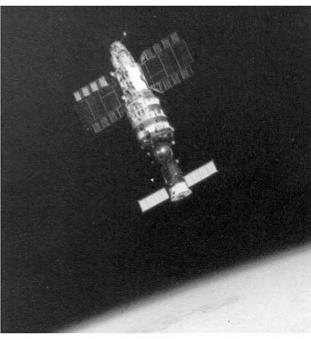Salyut
This highly successful programme began with the first unmanned launch in April 1971 and ended with the de-orbiting of Salyut 7 in February 1991. Two of the stations (Salyut 3 and Salyut 5) were military bases called Almaz. The differences between the “military” (Almaz, or Diamond) and the “civilian” (DOS, Russian for Permanent Orbital Station) stations were in their orbital parameters, durations, the composition of crew members (military officers and engineers for Almaz against civilian flight engineers and guest cosmonauts for Salyut), the openness of reporting of crew activities, and the research programmes. There were setbacks – the first crew to Salyut 1 could not enter the station, the second lost their lives in a re-entry accident, and there were five Soyuz missions which failed to achieve a docking with the station. In addition, there was a launch abort and a pad abort which cancelled Salyut missions. An unmanned Salyut was lost in a launch failure in July 1972, and in April 1973, Salyut (Almaz) 2 was lost shortly after entering orbit. This was followed the next month by the loss of Cosmos 557, which failed even before it received a Salyut identification. Salyut 4, 5, 6 and 7, however, pushed the boundaries of space endurance and demonstrated the wide range of experiments that could be conducted. The missions also demonstrated how much maintenance and trouble-shooting could be conducted. Salyut 6 and 7 also housed a series of visitors from Interkosmos and other countries, flying one-week visiting missions under the command of a veteran Soviet cosmonaut.
|
An artists impression of Salyut 1 in orbit, with a Soyuz on docking approach |
|
Salyut 7 in orbit |
|
Table 3.2. Salyut and Almaz stations
|
Featuring dual-docking ports, the later Salyut stations allowed crews to dock a pair of Soyuz craft to the same station, or dock a Progress unmanned re-supply craft to re-stock the resident crew or re-supply the consumables on board, thus prolonging the operational life of the station. The US Skylab programme had no such facilities.
The hybrid Salyut was a cylindrical structure, featuring two habitable compartments (transfer and work), with an internal docking port at the front and a modified Soyuz propulsion system at the rear. Power was supplied by two pairs of Soyuz solar panels. The overall length of the station was 15.8 m, with a maximum diameter of 4.15m and a 90m3 habitable volume. The average mass at launch was 18,900kg.
The Salyut 3 and 5 (Almaz) stations were different in design. Still cylindrical, the Soyuz docked with a rear port instead of a forward port. There was an airlock chamber for EVAs (although none were ever conducted from either Almaz), a work compartment and a living compartment. Almaz was 14.55 m long, with a maximum diameter of 4.15m and a similar habitable volume to that of Salyut. The station had larger arrays, however, and incorporated a detachable data capsule that could be ejected at the end of the military-orientated mission.
Salyut 4 was very similar to Salyut 1 but featured three steerable solar arrays, with a larger surface area and more capacity to produce electricity for the increased number of science experiments.
Salyut 6 and 7 resembled the earlier Salyuts but featured docking ports at the front and back, giving the capacity to re-supply and refuel the station using Progress freighters. Two Soyuz vessels could dock at the same time and the first EVAs for Soviet cosmonauts since 1969 were conducted from these stations. These record-breaking vehicles laid the ground work for Mir, testing hardware, techniques and systems for the larger and more capable station that would follow.












